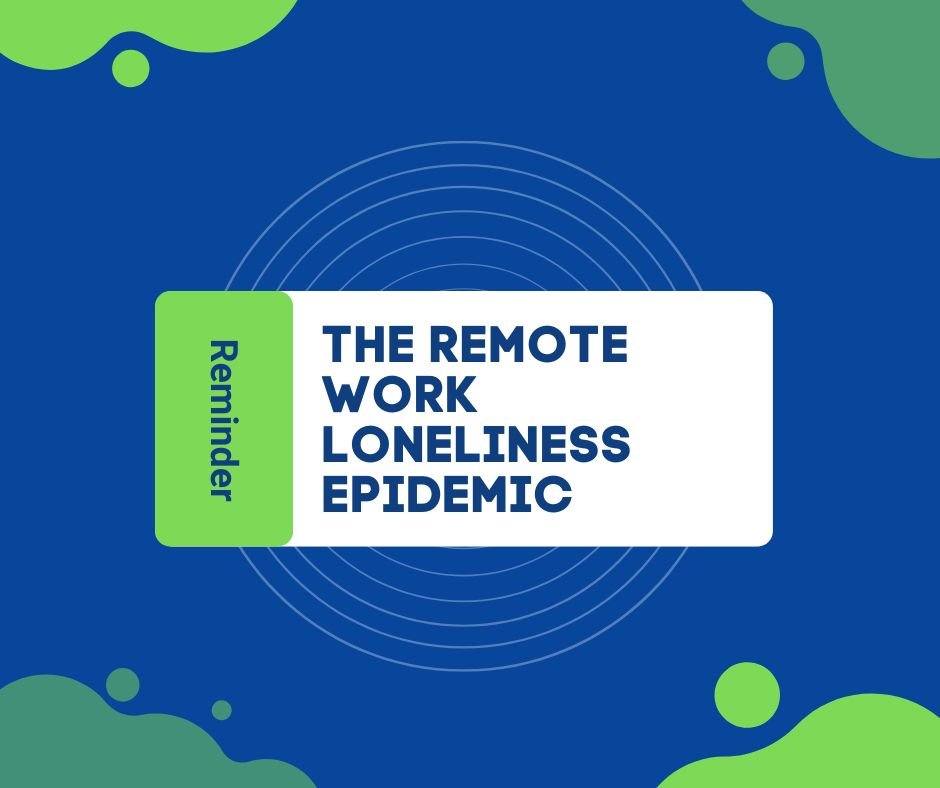The shift to remote work has given employees unprecedented flexibility—no commutes, no office distractions, and the freedom to work from anywhere. But beneath the surface of this modern work revolution lies a growing, often unspoken problem: loneliness.
A 2024 report by Gallup revealed that 67% of remote workers experience loneliness at least once a week, with 32% reporting chronic feelings of isolation. Even more concerning? Loneliness doesn’t just hurt morale—it reduces productivity by up to 20% (Harvard Business Review).
Why Remote Work Loneliness is Worse Than You Think
Unlike traditional office environments, where casual conversations and spontaneous interactions naturally occur, remote work strips away these micro-connections. The result?
- Digital fatigue: Endless Zoom calls and Slack messages don’t replace real human connection—they often make it feel more transactional.
- The “ghost colleague” effect: When you rarely see teammates in person, relationships become abstract, leading to weaker collaboration and trust.
- No work-life separation: Without the natural social rhythms of an office (lunch breaks, coffee chats), remote workers often work longer hours but feel more disconnected.
Dr. Vivek Murthy, former U.S. Surgeon General, warns: “Loneliness is as harmful to health as smoking 15 cigarettes a day.” For remote workers, this isn’t just a personal issue—it’s a productivity crisis.
5 Signs You’re Suffering From Remote Work Loneliness
- You procrastinate more than usual (because no one’s around to keep you accountable).
- You feel “out of the loop” on team decisions, even though you’re CC’d on emails.
- You dread virtual meetings—not because of the work, but because they feel hollow.
- You overwork to compensate—hoping productivity will fill the social void.
- You miss small talk—even the office chatter you once found annoying.
If this sounds familiar, you’re not alone. But the good news? There are proven ways to fix it.

How Top Remote Companies Are Fighting Loneliness
1. “Virtual Water Coolers” (Used by GitLab & Zapier)
- Dedicated Slack channels for non-work chats (#pets, #food, #random)
- Weekly “coffee roulette” pairings for casual video calls
- Result: 45% increase in team bonding (Buffer, 2024)
2. Async Video Updates (Pioneered by Loom & Shopify)
- Replace long emails with 2-minute video summaries
- Encourages more personal, face-to-face communication without scheduling hell
- Result: 30% fewer misunderstandings (Forrester)
3. In-Person Retreats (Airbnb & Doist)
- Even fully remote teams meet 2-4 times per year
- Not for work—just for reconnecting as humans
- Result: 50% lower turnover (Remote.co)
4. “Focus Buddies” (Tested by Asana)
- Pair up with a colleague for silent co-working sessions (like a virtual library)
- Provides gentle accountability + passive social presence
- Result: 28% higher focus rates (Stanford)
Your 30-Day Plan to Beat Remote Loneliness
Week 1: Rebuild Micro-Connections
- Send one “just because” message daily to a teammate (e.g., “Loved your presentation!”)
- Replace 3 emails with voice notes (more personal, less isolating)
- Join one non-work-related Slack channel
Week 2: Upgrade Your Virtual Presence
- Turn on your camera at least once per meeting (even if just for check-ins)
- Use virtual backgrounds that spark conversation (e.g., travel photos, fun artwork)
- Schedule one “walk-and-talk” call (movement + conversation = better connection)
Week 3: Create Offline Balance
- Set a hard stop time and leave your workspace
- Join a local coworking space or café 1-2x per week
- Plan one in-person activity with a colleague (even if just lunch)
Week 4: Advocate for Change
- Propose a monthly team “fun call” (game night, talent show, etc.)
- Suggest an async “kudos channel” where teammates celebrate wins
- Ask leadership about annual retreats or local meetups
Tools to Stay Connected Without Burning Out
- Donut (Slack) – Automates virtual coffee chats
- Gather (Virtual Office) – Lets you “bump into” coworkers like in real life
- Kona (Wellbeing Check-Ins) – Detects loneliness signals in remote teams
- Vowel (Meeting Notes) – Makes video calls more engaging and searchable
The Future of Remote Work: Social by Design
The most successful remote companies of the future won’t just focus on productivity—they’ll design workflows that keep people connected.
- “Loneliness KPIs” – Tracking team connection as seriously as output
- Hybrid Hangouts – Mixing virtual and in-person interactions
- Silent Socializing – More passive presence (e.g., shared Spotify playlists, always-on coworking rooms)

As organizational psychologist Adam Grant puts it: “Remote work doesn’t have to mean remote relationships. The best teams don’t just work together—they stay together.”
Key Takeaways
- Loneliness is remote work’s silent productivity killer
- Small, consistent social habits > forced “fun” activities
- Async video and in-person meetups bridge the gap
- Leaders must measure connection, not just output
- The future of remote work is flexible but socially intentional
The remote work revolution doesn’t have to be lonely. By rebuilding human connection in digital spaces, we can create workplaces that are both productive and fulfilling—no office required

